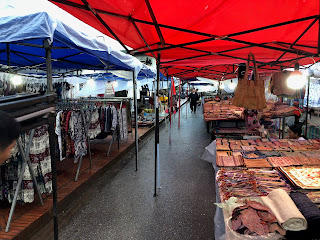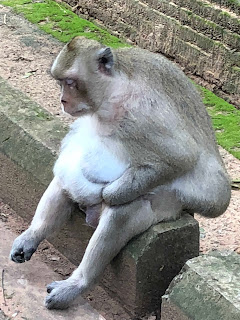Forget about Big Brother. In this city
Big Buddha is...well, I don't know whether he's watching you. From what I know about him, and what I understand about Buddhism (which, I admit, isn't much), I don't think he would want to.
Still, it's hard to deny that the man taught much by example. I would say that even if he weren't about 20 times my size!
You can find that statue of him--the largest in this city, and one of the largest in the world
in the Wat Wison Narath, the oldest operating Buddhist temple in this city--Luang Prabang, Laos. I arrived here last night in a heavy rain that didn't let up until late this afternoon. This original temple on this site was completed in 1513, burned in 1887 and rebuilt. Although it charges a small admission fee (20,000 kp: about $2.50 at current exchange rates), it still operates as a temple and thus, visitors are told, a procession of monks might enter the premises. And, as in other functioning Buddhist temples, visitors are required to leave their shoes and hats at the door. Also, silence and modesty (no revealing garments) are expected.
I must admit that, if nothing else, I felt very relaxed, as I wasn't thinking about the things I normally think about. In fact, I wasn't thinking at all. I didn't try to achieve that: It just sort of happened. Maybe it had to do with the calm in that place.
The funny thing is, I've felt really calm since I've been here--even in the central part of town, where most of the shops (and tourists) are. Maybe it has to do with all of the temples in this town: There seems to be one on every other block.
The guest house in which I'm staying is on the Nam Khan River. This city is built on a peninsula. At the tip of it, the Nam Khan merges with the Mekong, one of the world's mightiest rivers.
I haven't been to China, and won't make it there on this trip. But if it's any part of it is like Laos or Cambodia, it makes perfect sense to me now that one of its major rivers is called the Yellow River: waterways in this part of the world seem muddier than in other places I've seen. Part of the reason was literally at my feet when I descended some stone steps used by fishermen to the shore of the Meking, probably no more than 100 meters below the Nam Kahn confluence.
Speaking of fishermen, one waved to me and didn't seem to mind that I was photographing him.
The fishing might be the easier part of his job: I can only imagine what it's like to navigate his boat--not much different from what his forebears used centuries ago--in the raging waters. (I must say that this is the first time I've seen muddy waters with such a visibly strong current!)
Later, after the rain stopped, a couple of streets in the center of town were closed off to make the Night Market, a kind of bazaar with tents overhead. This city is justly famous for its fabrics: Local artisans pride themselves on their skills in weaving and coloring silk, cotton and wool.
Before I headed down the aisles, I snacked on something called "coconut pancakes". They are about the size of small macarons, and their insides have an almost custard-like texture. They're served in a "cup" made of banana leaves and were well worth the calories!
I did a bit of a splurge, buying a sarong skirt, a pair of shorts that look like they could pass a sarong, a scarf, two zippered pouches and a batik collage fabric figure of a cat I probably will give to my friend Mildred, who is caring for Marlee while I'm away. I bought an embroidered patch of the Laotian flag and a refrigerator magnet. The total? 257,000 kip. The current rate is around 8500 kip to the dollar. I'll let you do the math, since you probably are better at it than I am.
After all that, I went to a restaruant called the for a traditional Lao meal. Laap consists of marinated meat, with a combination greens and spices. Sometimes the marinating "cooks" the chicken and it is served cold: something like an Asian ceviche It can also be cooked after marinating and served hot, as mine was. My laap had chicken, lemongrass and, according to the waiter, "morning glory." Surely he didn't mean the flower, did he? No, not quite: He meant the shoots and leaves of a flowering plant that's often called "water morning glory" or "river spinach" in English.
In any event, it was served--like most Lao dishes--with sticky rice. It's actually a different species from the rice most other people know: Its grains are shorter and it has a higher starch content--but no gluten. Although it's usually associated with Northern Thai food, its true origins are in Laos. As it happens, Northern Thailand has almost as many ethnic Lao people as Laos itself, so much of what is called "Northern Thai" or simply "Thai" in the US and other countries is really Laotian.
When I asked for chopsticks, the waiter gave me a somewhat condescending smile. So did a waitress who happened to overhear the conversation. You're really supposed to eat sticky rice with your hands and, in fact, use it as a utensil to scoop up your laap (or whatever else you're eating) much as Ethipians use injera, their pita-like bread.
This trip is proving to be educational in all sorts of ways!
Big Buddha is...well, I don't know whether he's watching you. From what I know about him, and what I understand about Buddhism (which, I admit, isn't much), I don't think he would want to.
Still, it's hard to deny that the man taught much by example. I would say that even if he weren't about 20 times my size!
You can find that statue of him--the largest in this city, and one of the largest in the world
in the Wat Wison Narath, the oldest operating Buddhist temple in this city--Luang Prabang, Laos. I arrived here last night in a heavy rain that didn't let up until late this afternoon. This original temple on this site was completed in 1513, burned in 1887 and rebuilt. Although it charges a small admission fee (20,000 kp: about $2.50 at current exchange rates), it still operates as a temple and thus, visitors are told, a procession of monks might enter the premises. And, as in other functioning Buddhist temples, visitors are required to leave their shoes and hats at the door. Also, silence and modesty (no revealing garments) are expected.
I must admit that, if nothing else, I felt very relaxed, as I wasn't thinking about the things I normally think about. In fact, I wasn't thinking at all. I didn't try to achieve that: It just sort of happened. Maybe it had to do with the calm in that place.
The funny thing is, I've felt really calm since I've been here--even in the central part of town, where most of the shops (and tourists) are. Maybe it has to do with all of the temples in this town: There seems to be one on every other block.
The guest house in which I'm staying is on the Nam Khan River. This city is built on a peninsula. At the tip of it, the Nam Khan merges with the Mekong, one of the world's mightiest rivers.
I haven't been to China, and won't make it there on this trip. But if it's any part of it is like Laos or Cambodia, it makes perfect sense to me now that one of its major rivers is called the Yellow River: waterways in this part of the world seem muddier than in other places I've seen. Part of the reason was literally at my feet when I descended some stone steps used by fishermen to the shore of the Meking, probably no more than 100 meters below the Nam Kahn confluence.
Speaking of fishermen, one waved to me and didn't seem to mind that I was photographing him.
The fishing might be the easier part of his job: I can only imagine what it's like to navigate his boat--not much different from what his forebears used centuries ago--in the raging waters. (I must say that this is the first time I've seen muddy waters with such a visibly strong current!)
Later, after the rain stopped, a couple of streets in the center of town were closed off to make the Night Market, a kind of bazaar with tents overhead. This city is justly famous for its fabrics: Local artisans pride themselves on their skills in weaving and coloring silk, cotton and wool.
Before I headed down the aisles, I snacked on something called "coconut pancakes". They are about the size of small macarons, and their insides have an almost custard-like texture. They're served in a "cup" made of banana leaves and were well worth the calories!
I did a bit of a splurge, buying a sarong skirt, a pair of shorts that look like they could pass a sarong, a scarf, two zippered pouches and a batik collage fabric figure of a cat I probably will give to my friend Mildred, who is caring for Marlee while I'm away. I bought an embroidered patch of the Laotian flag and a refrigerator magnet. The total? 257,000 kip. The current rate is around 8500 kip to the dollar. I'll let you do the math, since you probably are better at it than I am.
After all that, I went to a restaruant called the for a traditional Lao meal. Laap consists of marinated meat, with a combination greens and spices. Sometimes the marinating "cooks" the chicken and it is served cold: something like an Asian ceviche It can also be cooked after marinating and served hot, as mine was. My laap had chicken, lemongrass and, according to the waiter, "morning glory." Surely he didn't mean the flower, did he? No, not quite: He meant the shoots and leaves of a flowering plant that's often called "water morning glory" or "river spinach" in English.
In any event, it was served--like most Lao dishes--with sticky rice. It's actually a different species from the rice most other people know: Its grains are shorter and it has a higher starch content--but no gluten. Although it's usually associated with Northern Thai food, its true origins are in Laos. As it happens, Northern Thailand has almost as many ethnic Lao people as Laos itself, so much of what is called "Northern Thai" or simply "Thai" in the US and other countries is really Laotian.
When I asked for chopsticks, the waiter gave me a somewhat condescending smile. So did a waitress who happened to overhear the conversation. You're really supposed to eat sticky rice with your hands and, in fact, use it as a utensil to scoop up your laap (or whatever else you're eating) much as Ethipians use injera, their pita-like bread.
This trip is proving to be educational in all sorts of ways!
































